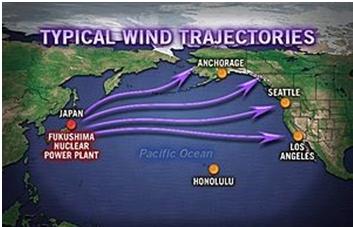 A United Nations forecast of the possible movement of the radioactive plume coming from crippled Japanese reactors shows it churning across the Pacific, and touching the Aleutian Islands on Thursday before hitting Southern California late Friday.
A United Nations forecast of the possible movement of the radioactive plume coming from crippled Japanese reactors shows it churning across the Pacific, and touching the Aleutian Islands on Thursday before hitting Southern California late Friday.
Health and nuclear experts emphasize that radiation in the plume will be diluted as it travels and, at worst, would have extremely minor health consequences in the United States, even if hints of it are ultimately detectable.
In a similar way, radiation from the Chernobyl disaster in 1986 spread around the globe and reached the West Coast of the United States in ten days, its levels measurable but minuscule. The cloud will however deposit radiation in higher doses in the oceanic waters between Japan and the USA and there is no healthy amount of radiation although some will have you believe that.
The projection, by the Comprehensive Test Ban Treaty Organization, an arm of the United Nations in Vienna, gives no information about actual radiation levels but only shows how a radioactive plume would probably move and disperse. Information about the levels should be made available to U.S. residents and people should not be treated like children with words like “low levels” or “virtually undetectable.”
The forecast, calculated Tuesday, is based on patterns of Pacific winds at that time and the predicted path is likely to change as weather patterns shift.


